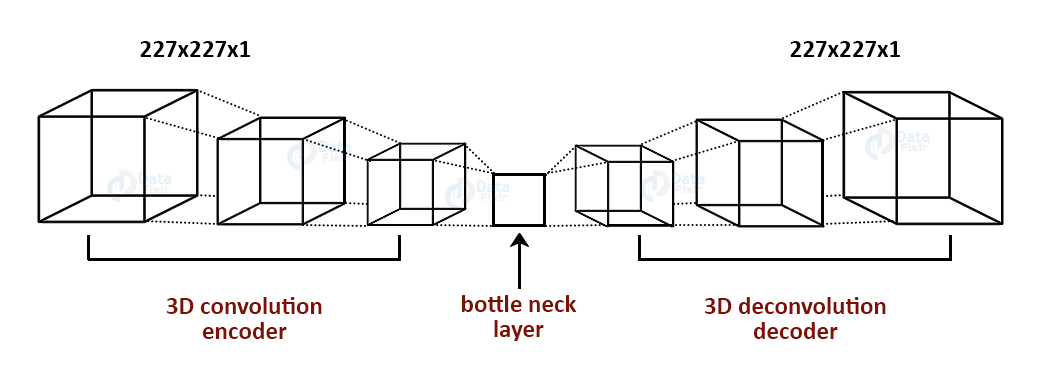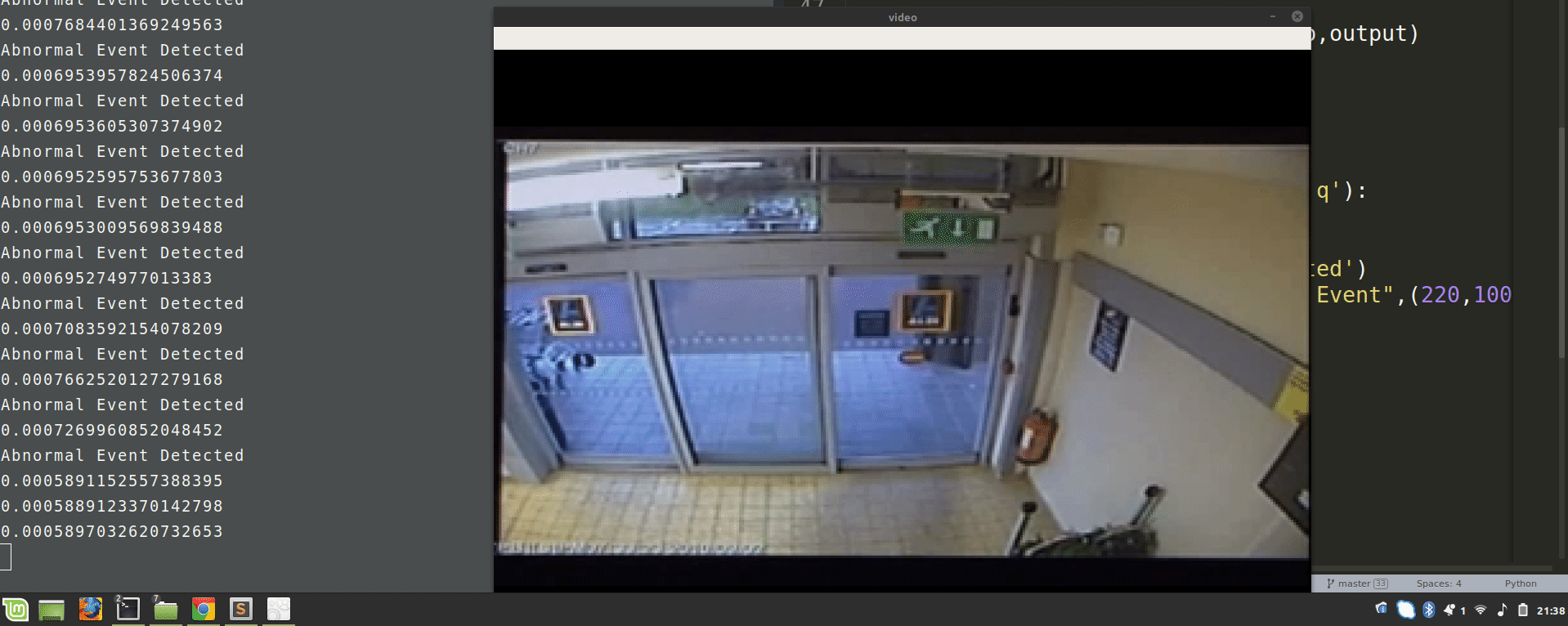Deep Surveillance with Deep Learning – Intelligent Video Surveillance Project
Free Machine Learning courses with 130+ real-time projects Start Now!!
Surveillance security is a very tedious and time-consuming job. In this tutorial, we will build a system to automate the task of analyzing video surveillance. We will analyze the video feed in real-time and identify any abnormal activities like violence or theft.
There is a lot of research going on in the industry about video surveillance among them; the role of CCTV videos has overgrown. CCTV cameras are placed all over the places for surveillance and security.
In the last decade, there have been advancements in deep learning algorithms for deep surveillance. These advancements have shown an essential trend in deep surveillance and promise a drastic efficiency gain. The typical applications of deep surveillance are theft identification, violence detection, and detection of the chances of explosion.
Network architecture:
We have generally seen deep neural networks for computer vision, image classification, and object detection tasks. In this project, we have to extend deep neural networks to 3-dimensional for learning spatio-temporal features of the video feed.
For this video surveillance project, we will introduce a spatio temporal autoencoder, which is based on a 3D convolution network. The encoder part extracts the spatial and temporal information, and then the decoder reconstructs the frames. The abnormal events are identified by computing the reconstruction loss using Euclidean distance between original and reconstructed batch.
Intelligent Video Surveillance with Deep Learning
We will use spatial temporal encoders to identify abnormal activities.
The dataset for abnormal event detection in video surveillance:
Following are the comprehensive datasets that are used to train models for anomaly detection tasks.
CUHK Avenue Dataset:
This dataset contains 16 training and 21 testing video clips. The video contains 30652 frames in total.
The training videos contain video with normal situations. The testing videos contain videos with both standard and abnormal events.
Dataset Download Link: Avenue Dataset for Abnormal Event Detection
UCSD pedestrian Dataset:
This dataset contains videos with pedestrians. It includes groups of people walking towards, away, and parallel to the camera. The abnormal event includes:
- Non-pedestrian entities
- Anomalous pedestrian motion patterns
Dataset Download Link: UCSD Anomaly Detection Dataset
Project Source Code
Before proceeding ahead, please download the source code which we used in this deep learning project: Video Surveillance Project Code
Video Surveillance – Anomaly Even Detection Code:
First, download any one of the above datasets and put in a directory named “train”.
Make a new python file train.py and paste the code described in following steps:
1. Imports:
from keras.preprocessing.image import img_to_array,load_img import numpy as np import glob import os import cv2 from keras.layers import Conv3D,ConvLSTM2D,Conv3DTranspose from keras.models import Sequential from keras.callbacks import ModelCheckpoint, EarlyStopping import imutils
2. Initialize directory path variable and describe a function to process and store video frames:
store_image=[]
train_path='./train'
fps=5
train_videos=os.listdir('train_path')
train_images_path=train_path+'/frames'
os.makedirs(train_images_path)
def store_inarray(image_path):
image=load_img(image_path)
image=img_to_array(image)
image=cv2.resize(image, (227,227), interpolation = cv2.INTER_AREA)
gray=0.2989*image[:,:,0]+0.5870*image[:,:,1]+0.1140*image[:,:,2]
store_image.append(gray)
3. Extract frames from video and call store function:
for video in train_videos:
os.system( 'ffmpeg -i {}/{} -r 1/{} {}/frames/%03d.jpg'.format(train_path,video,fps,train_path))
images=os.listdir(train_images_path)
for image in images:
image_path=train_image_path + '/' + image
store_inarray(image_path)
4. Store the store_image list in a numpy file “training.npy”:
store_image=np.array(store_image)
a,b,c=store_image.shape
store_image.resize(b,c,a)
store_image=(store_image-store_image.mean())/(store_image.std())
store_image=np.clip(store_image,0,1)
np.save('training.npy',store_image)
5. Create spatial autoencoder architecture:
stae_model=Sequential() stae_model.add(Conv3D(filters=128,kernel_size=(11,11,1),strides=(4,4,1),padding='valid',input_shape=(227,227,10,1),activation='tanh')) stae_model.add(Conv3D(filters=64,kernel_size=(5,5,1),strides=(2,2,1),padding='valid',activation='tanh')) stae_model.add(ConvLSTM2D(filters=64,kernel_size=(3,3),strides=1,padding='same',dropout=0.4,recurrent_dropout=0.3,return_sequences=True)) stae_model.add(ConvLSTM2D(filters=32,kernel_size=(3,3),strides=1,padding='same',dropout=0.3,return_sequences=True)) stae_model.add(ConvLSTM2D(filters=64,kernel_size=(3,3),strides=1,return_sequences=True, padding='same',dropout=0.5)) stae_model.add(Conv3DTranspose(filters=128,kernel_size=(5,5,1),strides=(2,2,1),padding='valid',activation='tanh')) stae_model.add(Conv3DTranspose(filters=1,kernel_size=(11,11,1),strides=(4,4,1),padding='valid',activation='tanh')) stae_model.compile(optimizer='adam',loss='mean_squared_error',metrics=['accuracy'])
6. Train the autoencoder on the “training.npy” file and save the model with name “saved_model.h5”:
training_data=np.load('training.npy')
frames=training_data.shape[2]
frames=frames-frames%10
training_data=training_data[:,:,:frames]
training_data=training_data.reshape(-1,227,227,10)
training_data=np.expand_dims(training_data,axis=4)
target_data=training_data.copy()
epochs=5
batch_size=1
callback_save = ModelCheckpoint("saved_model.h5", monitor="mean_squared_error", save_best_only=True)
callback_early_stopping = EarlyStopping(monitor='val_loss', patience=3)
stae_model.fit(training_data,target_data, batch_size=batch_size, epochs=epochs, callbacks = [callback_save,callback_early_stopping])
stae_model.save("saved_model.h5")
Run this script to train and save the autoencoder model.
Now make another python file “test.py” and observe the results of abnormal event detection on any custom video.
Paste the below code in “test.py”:
import cv2
import numpy as np
from keras.models import load_model
import argparse
from PIL import Image
import imutils
def mean_squared_loss(x1,x2):
difference=x1-x2
a,b,c,d,e=difference.shape
n_samples=a*b*c*d*e
sq_difference=difference**2
Sum=sq_difference.sum()
distance=np.sqrt(Sum)
mean_distance=distance/n_samples
return mean_distance
model=load_model("saved_model.h5")
cap = cv2.VideoCapture("__path_to_custom_test_video")
print(cap.isOpened())
while cap.isOpened():
imagedump=[]
ret,frame=cap.read()
for i in range(10):
ret,frame=cap.read()
image = imutils.resize(frame,width=700,height=600)
frame=cv2.resize(frame, (227,227), interpolation = cv2.INTER_AREA)
gray=0.2989*frame[:,:,0]+0.5870*frame[:,:,1]+0.1140*frame[:,:,2]
gray=(gray-gray.mean())/gray.std()
gray=np.clip(gray,0,1)
imagedump.append(gray)
imagedump=np.array(imagedump)
imagedump.resize(227,227,10)
imagedump=np.expand_dims(imagedump,axis=0)
imagedump=np.expand_dims(imagedump,axis=4)
output=model.predict(imagedump)
loss=mean_squared_loss(imagedump,output)
if frame.any()==None:
print("none")
if cv2.waitKey(10) & 0xFF==ord('q'):
break
if loss>0.00068:
print('Abnormal Event Detected')
cv2.putText(image,"Abnormal Event",(100,80),cv2.FONT_HERSHEY_SIMPLEX,2,(0,0,255),4)
cv2.imshow("video",image)
cap.release()
cv2.destroyAllWindows()
Now, run this script and observe the results of video surveillance, it will highlight the abnormal events.
Summary:
In this deep learning project, we train an autoencoder for abnormal event detection. We train the autoencoder on normal videos. We identify the abnormal events based on the euclidean distance of the custom video feed and the frames predicted by the autoencoder.
We set a threshold value for abnormal events. In this project, it is 0.0068; you can vary this threshold to experiment getting better results.
Did we exceed your expectations?
If Yes, share your valuable feedback on Google





Hi,
What would be the ‘framepath’ in this line of code?
image_path=framepath+ ‘/’+ image
It is : image_path=train_image_path+’/’+image
Can someone just post the sequence in which we have to run all the files.And after which the output screen will come
hi Thanks for your effort, may I have the saved_model.h5 please?
Yes, can lease someone share the trained model?
Do you have saved_model.h5? Can you share it to me please
hello sir if you that trained h5 model please share to me
there is some problem that I’m facing, that is unable to complete model.fit function
hey.. how can I contact you? I need some help with the project. Please respond whenever you can
What is the software used to run the code?
Hi ,
I have few questions about this project, is there any platform on which I can discuss with you?
which dataset used for this work ?? Can you give the colab link possible
could you give some details about the that
The store_image list will not contain any data and the numpy file therefore generated will have NaN.
Can anyone help me with this?
I almost recreated it with little extra features.
Bro i need full source code and detail bro send me pls
Bro I am also want to recreate this project into another please help me by sending any details about the errors and running procedure
what is the shape of bottle neck layer?
a,b,c=store_image.shape
ValueError: not enough values to unpack (expected 3, got 1)
why does this error occurs?
Same error
Hi Thanks for this great post. I successfully made it.
how bro send me please
i have few doubts regarding the code.
could you pls help me
What is your doubt?
a,b,c=store_image.shape
ValueError: not enough values to unpack (expected 3, got 1)
i am getting this error
pls help
The reason is code for extraction of frames from the training videos doesn’t work as it should be working. So the array file where the values are stored contains [0,,] than a three dimensional value.
Can someone share the trained model file?
Do you have saved_model.h5? Can you share it to me please
what is the data set which you used in above summary??
Are there any other data sets??
When I run the program train.py, the program runs but there is a warninig-
WARNING:tensorflow:Can save best model only with mean_squared_error available, skipping.
WARNING:tensorflow:Early stopping conditioned on metric `val_loss` which is not available. Available metrics are: loss,accuracy
Could you please say how to correct this
a,b,c=store_image.shape
ValueError: not enough values to unpack (expected 3, got 1)
why does this error occurs?
And how to rectify it?
Please reply …..
a,b,c=store_image.shape
ValueError: not enough values to unpack (expected 3, got 1)
why does this error occurs?
Thanks. I can successfully recreate the Model with some minor modifications.
Thanks for your efforts.
a,b,c=store_image.shape
ValueError: not enough values to unpack (expected 3, got 1)
did you manage to solve this? Please if you manage to to then say us how to do it
a,b,c=store_image.shape
ValueError: not enough values to unpack (expected 3, got 1)
how to solve this problem?
Hello, my name is Joseph Mendez and I am from Peru(South America).
I am currently working on a similar project regarding Car Theft detection using Neural Networks.
The problem we are now facing is due to the dataset. I wanted to ask you whether you know how can I get a dataset for the project I am currently working on.
Maybe you know some database or anyone that can help me regarding Car Assaults in CCTV images.
Thanks in advance for your support,
Joseph Mendez
When I run the program train.py, the program runs but there is a warninig-
WARNING:tensorflow:Can save best model only with mean_squared_error available, skipping.
WARNING:tensorflow:Early stopping conditioned on metric `val_loss` which is not available. Available metrics are: loss,accuracy
Could you please say how to correct this
same error i am getting and whren i run test i am getting the result as false please say how to solve this its very much required plz
train_path=’./train’
fps=5
train_videos=os.listdir(‘train_path’)
how to give the above file path
can you please help with this issue
can someone send me the link to download video that is tested on the model and shown in this tutorial
machine learning as in research perspective is still booming and everyday some new concept or a system gets innovated, in 2022 there is a still lot to be added into this field.
a,b,c=store_image.shape
ValueError: not enough values to unpack (expected 3, got 1)
can someone help me with this??
how do i solve this error??
CAN ANYONE SEND THE LINK TO THE COMPLETE PROJECT CODE?
please make a complete video guide of this project as we can do it easily
Hi bro it shows an image size only one dimension
And it gives an error not enough values to unpack